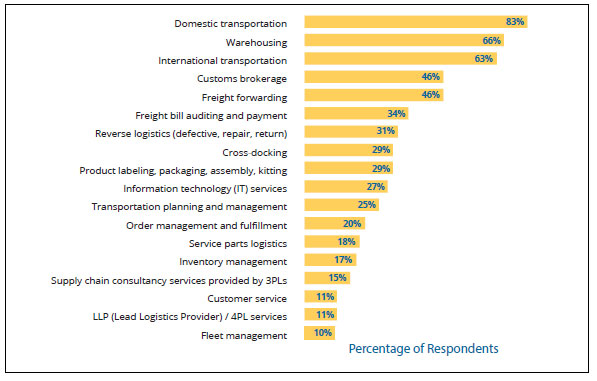
by logisticsplus | Nov 15, 2017 | News
In case you haven’t had a chance to read the 2018 Third-Party Logistics Study, here are some key takeaways from the results and findings of the 22nd annual report by Dr. C. John Langley and Infosys:
- Global Results Have Been Mixed. Overall 3PL revenues, estimated at $802B in 2016, have declined slightly over the past several years despite increases in the Asia-Pacific and North America.
- Logistics Costs Are Increasing. Logistics expenditures as a percentage of sales revenues increased to 11% in the current year, up from 10% the previous year, as a higher percentage of shippers’ transportation spend is being outsourced with 3PLs (reportedly 55% in most current year).
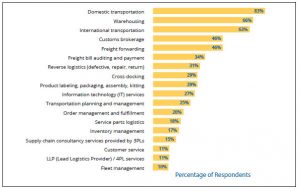 Shippers Are Outsourcing More. 61% of shippers in the study noted that they intend to increase their usage of outsourced logistics services. Domestic transportation and warehousing remain the two most outsourced logistics services; however, outsourcing of information technology (IT) services had the greatest year-over-year increase for the second consecutive year (see graph).
Shippers Are Outsourcing More. 61% of shippers in the study noted that they intend to increase their usage of outsourced logistics services. Domestic transportation and warehousing remain the two most outsourced logistics services; however, outsourcing of information technology (IT) services had the greatest year-over-year increase for the second consecutive year (see graph).- The IT Satisfaction Gap Is Widening. Despite more outsourcing of IT activities, fewer shippers are satisfied with these services; an indication that, perhaps, shippers’ expectations have increased as technology has improved or because shippers are seeking enhanced analytical capabilities to help drive more effective supply chain decisions.
- 3PL Capabilities Are Expanding. As more conversations around supply chain efficiency have entered the board room, 3PL providers are refining and expanding their core competencies, which in turn is allowing shippers to focus more on their core competencies.
If you haven’t already, you should download and read the entire 2018 Third-Party Logistics Study. The authors also share some perspectives on the impact blockchains could have on logistics; automation and digitization in the supply chain; and the logistics talent revolution.
If you’re a shipper looking to outsource some or all of your transportation, logistics, or supply chain activities, let us know. We stand ready to help businesses address their most critical logistics challenges.


by logisticsplus | Nov 13, 2017 | News
 Congratulations to Jim Berlin, founder and CEO of Logistics Plus, for receiving his Smart 50 honors last week in Pittsburgh, PA. As reported last month, Jim was selected this year by the judging panel of Smart Business Pittsburgh to be a 2017 Smart 50 Award honoree. All 50 winners were honored at a special celebration on November 9th at The Fairmont Pittsburgh and featured in a special editorial report in the November edition of Smart Business Pittsburgh. In addition to receiving a recognition plaque, and providing some brief acceptance comments, Jim was also honored with his own star of honor (see photos below). Congratulations once again Jim, and thank you for your smart business leadership!
Congratulations to Jim Berlin, founder and CEO of Logistics Plus, for receiving his Smart 50 honors last week in Pittsburgh, PA. As reported last month, Jim was selected this year by the judging panel of Smart Business Pittsburgh to be a 2017 Smart 50 Award honoree. All 50 winners were honored at a special celebration on November 9th at The Fairmont Pittsburgh and featured in a special editorial report in the November edition of Smart Business Pittsburgh. In addition to receiving a recognition plaque, and providing some brief acceptance comments, Jim was also honored with his own star of honor (see photos below). Congratulations once again Jim, and thank you for your smart business leadership!
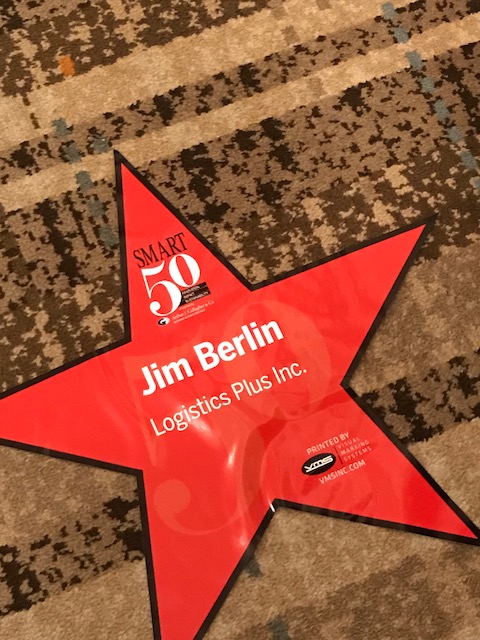


by logisticsplus | Nov 2, 2017 | News
FOR IMMEDIATE RELEASE
Patrick Randolph Joins Logistics Plus as New Warehousing & Fulfillment Executive
Logistics Plus will also acquire all Lynx Fulfillment assets and employees and rebrand the company as Logistics Plus Fulfillment Solutions
ERIE, PA (November 2, 2017) – Logistics Plus Inc., a leading worldwide provider of transportation, logistics and supply chain solutions, is proud to announce that Patrick Randolph has joined the company to head up its fast-growing Logistics Plus (LP) Fulfillment Solutions division. LP Fulfillment offers a complete set of warehousing, pick, pack, and ship fulfillment solutions customized for ecommerce retailers, wholesalers, and Amazon sellers.
Randolph will work closely with existing Logistics Plus warehousing personnel in support of incoming requests for pricing, program executions, fulfillment workflow designs, new facility evaluations, and customer integrations. Logistics Plus currently has over one million square feet of warehousing and fulfillment space across the United States, with access to additional space through its strategic partnerships.
Randolph has nearly two decades of operations and fulfillment experience. For the past nine years, Randolph has been the Managing Director of Lynx Fulfillment, LLC based in Olean, NY with a second location in southern California. Lynx Fulfillment was partially-owned by Logistics Plus. As part of the agreement, Lynx Fulfillment will be acquired and rebranded as LP Fulfillment, and will be operated entirely by Randolph and the Logistics Plus management team.
“The opportunity to join such a dynamic and fast-growing organization is an honor,” said Randolph. “I have long admired the Logistics Plus spirit and look forward to making a difference.”
“We’re excited to welcome Patrick and the Lynx Fulfillment team into the larger Logistics Plus family,” said Jim Berlin, founder and CEO for Logistics Plus. “Our fulfillment solutions continue to be an area of high-growth and high-interest for us. As an approved member of the Amazon Solutions Provider Network, I see even more growth opportunities for us going forward. Having Patrick and his team on board will really take this key area to the next-level.”
About Lynx Fulfillment, LLC
Lynx Fulfillment, LLC is a leader in the warehousing and fulfillment industry. Its business model has been designed to deliver fast and accurate order fulfillment services, exceptional technology and dedicated customer service. Lynx Fulfillment guarantees that it will ship every order received by 2 P.M. the same day with 100% accuracy. Lynx Fulfillment, with over a dozen employees, is headquartered in Olean, NY, and has a second operation in Los Angeles (Carson), CA. Learn more at www.lynxfulfillment.com.
About Logistics Plus Inc.
Logistics Plus Inc. provides freight transportation, warehousing, global logistics, and supply chain management solutions through a worldwide network of talented and caring professionals. Founded in Erie, PA by local entrepreneur, Jim Berlin, 21 years ago, Logistics Plus is a fast-growing and award-winning transportation and logistics company. With a strong passion for excellence, its 450+ employees put the “Plus” in logistics by doing the big things properly, and the countless little things, that together ensure complete customer satisfaction and success.
The Logistics Plus® network includes offices located in Erie, PA; Alma, AR; Little Rock, AR; Los Angeles, CA; Riverside, CA; San Francisco, CA; Visalia, CA; Atlanta, GA; Chicago, IL; Detroit, MI; Kansas City, MO; Charlotte, NC; Lexington, NC; Buffalo, NY; Olean, NY; Cleveland, OH; Charleston, SC; Greenville, SC; Nashville, TN; Dallas, TX; Fort Worth, TX; Houston, TX; Laredo, TX; Winchester, VA; Madison, WI; Australia; Bahrain; Belgium; Canada; Chile; China; Colombia; Egypt; France; Germany; Hong Kong; India; Indonesia; Kazakhstan; Kenya; Libya; Mexico; Poland; Saudi Arabia; Singapore; South Sudan; Taiwan; Turkey; UAE; and Uganda; with additional agents around the world. For more information, visit www.logisticsplus.com or follow @LogisticsPlus on Twitter.
Media Contact:
Scott G. Frederick
Vice President, Marketing
Logistics Plus Inc.
(814) 240-6881
scott.frederick@logisticsplus.com
Click the image below to download the Logistics Plus logo:


by logisticsplus | Nov 2, 2017 | News
FOR IMMEDIATE RELEASE
Logistics Plus Acquires Lynx Fulfillment, LLC
All Lynx Fulfillment, LLC assets and employees will be rebranded as Logistics Plus Fulfillment Solutions

ERIE, PA (November 2, 2017) – Logistics Plus Inc., a leading worldwide provider of transportation, logistics and supply chain solutions, announced today that it has acquired complete ownership of Lynx Fulfillment, LLC. Prior to the acquisition, Lynx Fulfillment was partially-owned by Logistics Plus. As part of the agreement, Lynx Fulfillment will be rebranded as Logistics Plus Fulfillment Solutions (aka LP Fulfillment). Additionally, Patrick Randolph, the Managing Director and partial-owner of Lynx Fulfillment, has joined Logistics Plus to head up its fast-growing LP Fulfillment division.
Lynx Fulfillment is based in Olean, NY with over 40,000 square feet of dedicated warehousing and fulfillment space. It has a second 10,000 square-foot operation located in Carson, CA. The company, which specializes in customized pick, pack, and ship order fulfillment solutions, has over 60 clients and employs over a dozen experienced warehousing, fulfillment and customer service specialists. All assets and employees were transitioned to Logistics Plus effective November 1, 2017.
“This is great news for both Lynx and LP clients,” said Randolph. “Lynx clients will enjoy the same personalized and professional services they had before, but now, as part of a larger, global organization, they’ll have access to additional services and resources. LP clients benefit by getting ready-access to additional warehousing and fulfillment capabilities, which now include well over one-million square feet of warehousing space at multiple locations across North America.”
“We’re excited to welcome Patrick and the Lynx Fulfillment team into the larger Logistics Plus family,” said Jim Berlin, founder and CEO for Logistics Plus. “Our fulfillment solutions continue to be an area of high-growth and high-interest for us. As an approved member of the Amazon Solutions Provider Network, I see even more growth opportunities for us going forward. Having Patrick and his team on board will really take this key area to the next-level.”
Learn more about Logistics Plus Fulfillment Solutions at www.logisticsplus.com/fulfillment.
About Lynx Fulfillment, LLC
Lynx Fulfillment, LLC is a leader in the warehousing and fulfillment industry. Its business model has been designed to deliver fast and accurate order fulfillment services, exceptional technology and dedicated customer service. Lynx Fulfillment guarantees that it will ship every order received by 2 P.M. the same day with 100% accuracy. Lynx Fulfillment, with over a dozen employees, is headquartered in Olean, NY, and has a second operation in Los Angeles (Carson), CA. Learn more at www.lynxfulfillment.com.
About Logistics Plus Inc.
Logistics Plus Inc. provides freight transportation, warehousing, global logistics, and supply chain management solutions through a worldwide network of talented and caring professionals. Founded in Erie, PA by local entrepreneur, Jim Berlin, 21 years ago, Logistics Plus is a fast-growing and award-winning transportation and logistics company. With a strong passion for excellence, its 450+ employees put the “Plus” in logistics by doing the big things properly, and the countless little things, that together ensure complete customer satisfaction and success.
The Logistics Plus® network includes offices located in Erie, PA; Alma, AR; Little Rock, AR; Los Angeles, CA; Riverside, CA; San Francisco, CA; Visalia, CA; Atlanta, GA; Chicago, IL; Detroit, MI; Kansas City, MO; Charlotte, NC; Lexington, NC; Buffalo, NY; Olean, NY; Cleveland, OH; Charleston, SC; Greenville, SC; Nashville, TN; Dallas, TX; Fort Worth, TX; Houston, TX; Laredo, TX; Winchester, VA; Madison, WI; Australia; Bahrain; Belgium; Canada; Chile; China; Colombia; Egypt; France; Germany; Hong Kong; India; Indonesia; Kazakhstan; Kenya; Libya; Mexico; Poland; Saudi Arabia; Singapore; South Sudan; Taiwan; Turkey; UAE; and Uganda; with additional agents around the world. For more information, visit www.logisticsplus.com or follow @LogisticsPlus on Twitter.
Media Contact:
Scott G. Frederick
Vice President, Marketing
Logistics Plus Inc.
(814) 240-6881
scott.frederick@logisticsplus.com
Click image below to download the Logistics Plus logo:

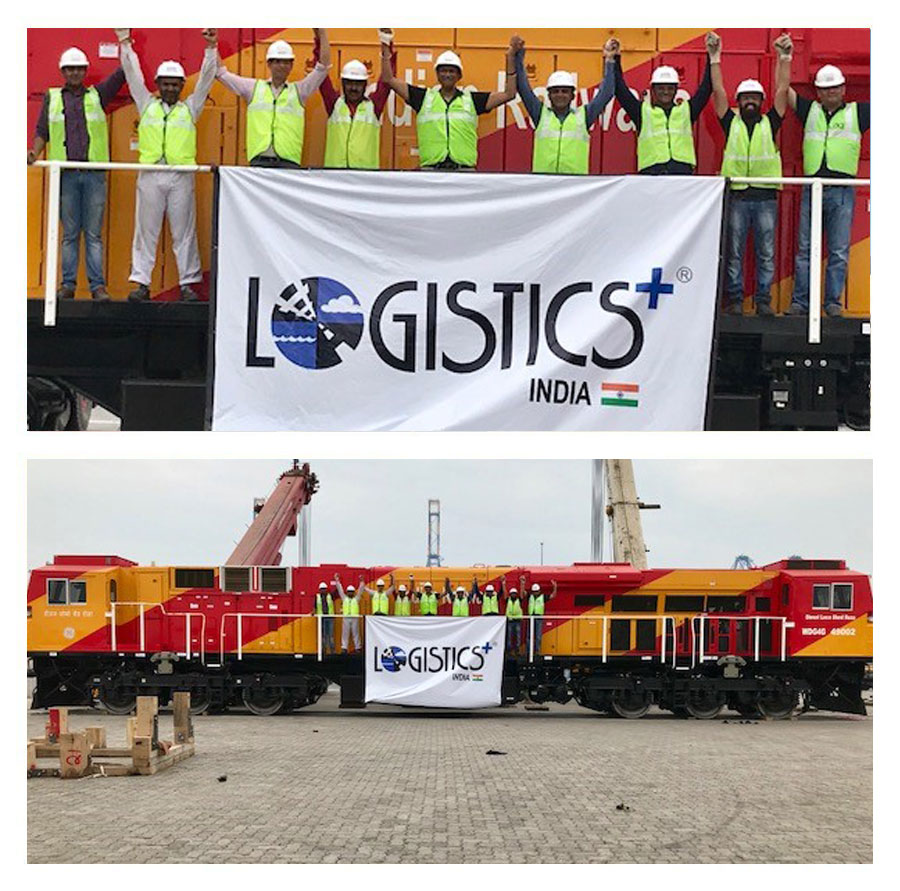
by logisticsplus | Oct 31, 2017 | News
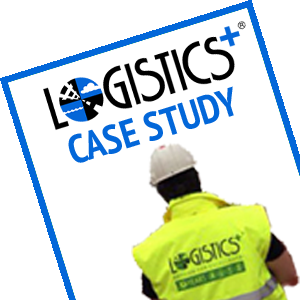 Here are two new projects recently completed by the Logistics Plus (LP) Project Cargo Team. For the first project shown below, the LP India team safely delivered the first GE locomotive from under hook to its track within 44 hours (for which we received a nice compliment from our customer). LP India’s scope was as follows:
Here are two new projects recently completed by the Logistics Plus (LP) Project Cargo Team. For the first project shown below, the LP India team safely delivered the first GE locomotive from under hook to its track within 44 hours (for which we received a nice compliment from our customer). LP India’s scope was as follows:
- Receiving cargo under hook;
- Customs clearance;
- The movement to identified location for the overnight halting of a locomotive; and
- All equipment including shackles, strings, spreader beams, traverser, jacks, etc., were designed and made (produced from specific vendors) specific to GE’s requirements.
The second project shown below was completed by the LP Houston team and involved the safe loading of coiled tubings at Port Houston.
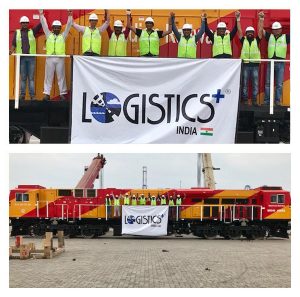
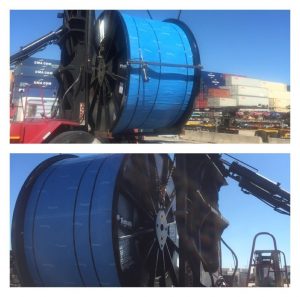
Need help with your big, oversize, breakbulk or heavy-lift project cargo? Let our award-winning team know!


 Shippers Are Outsourcing More. 61% of shippers in the study noted that they intend to increase their usage of outsourced logistics services. Domestic transportation and warehousing remain the two most outsourced logistics services; however, outsourcing of information technology (IT) services had the greatest year-over-year increase for the second consecutive year (see graph).
Shippers Are Outsourcing More. 61% of shippers in the study noted that they intend to increase their usage of outsourced logistics services. Domestic transportation and warehousing remain the two most outsourced logistics services; however, outsourcing of information technology (IT) services had the greatest year-over-year increase for the second consecutive year (see graph).


 Congratulations to Jim Berlin, founder and CEO of Logistics Plus, for receiving his Smart 50 honors last week in Pittsburgh, PA.
Congratulations to Jim Berlin, founder and CEO of Logistics Plus, for receiving his Smart 50 honors last week in Pittsburgh, PA. 







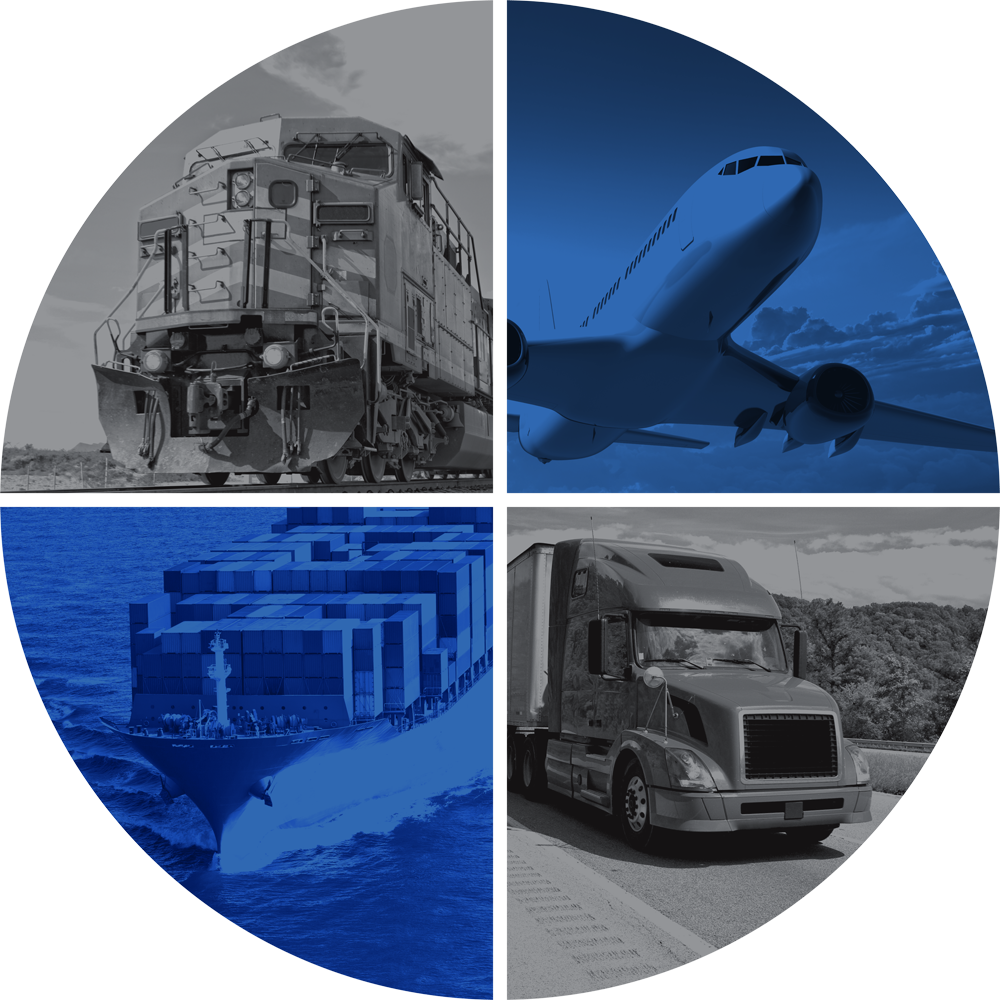
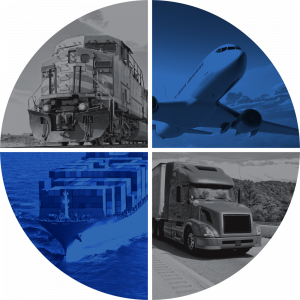 Here are the top 10 reasons why businesses need
Here are the top 10 reasons why businesses need 